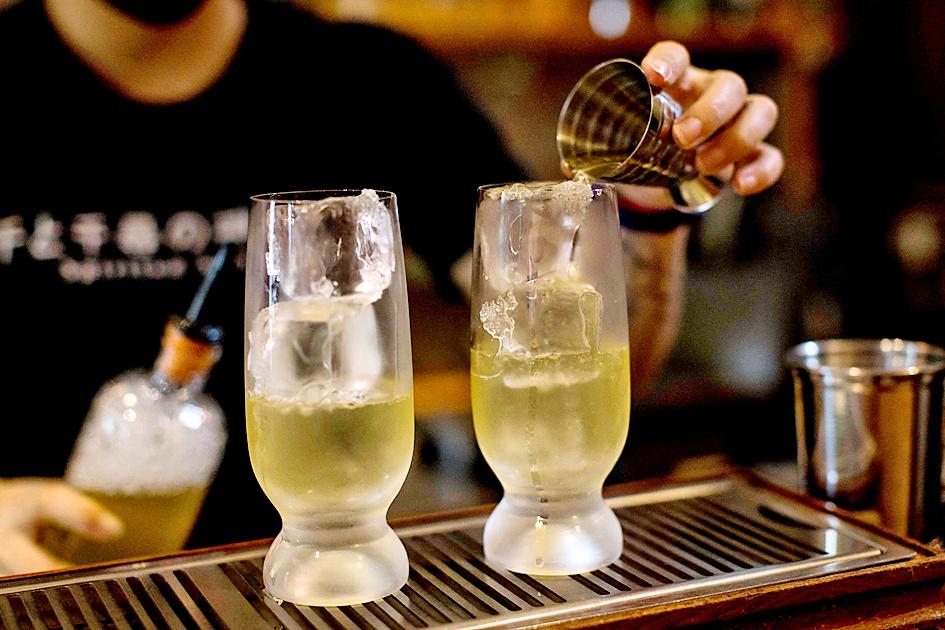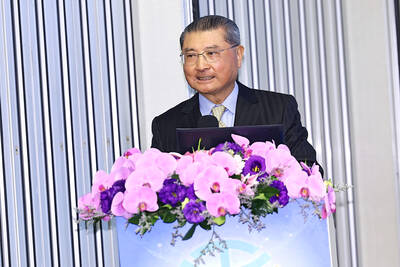While the Omicron variant of SARS-CoV-2 stirs up pandemic deja vu in the US with swamped hospitals, canceled flights and millions of people quarantined — one trend that dominated earlier COVID-19 waves is on the decline: binge boozing.
It has been widely documented that alcohol consumption surged in the US in 2020 and began to ease up last year. This year has begun with overwhelming participation in Dry January — 19 percent of American adults are abstaining from alcohol (or trying to) this month, according to one survey. What is surging now is the business of non-alcoholic booze.
Yes, mocktails are having their moment. While it is hard to take faux anything seriously, this latest trend is not as trivial as it may sound. Sales of non-alcoholic beverages spiked 33 percent to US$331 million in the past year, NielsenIQ reported last fall.

Photo: AFP
Going forward, the growing popularity of near-beers, “clean” wines and zero-proof spirits could follow a trajectory similar to the remarkable boom of faux meats.
Both trends are spearheaded by health-conscious millennials. Both also have important ethical and environmental implications. Just as the fake meat market has been built by brand new start-ups and old industry giants alike — from Impossible Foods and Beyond Meat to Tyson Inc and Cargill Inc — faux alcohol products are being peddled by both scrappy young beverage companies and legacy booze brands.
You might already recognize new brands like Curious Elixirs, Kin Euphorics and Seedlip — the latter having been purchased Diageo PLC, parent company of Smirnoff, Johnnie Walker and Guinness.
These zero-proof liquors and mixers are being marketed as an extension of the bougie craft cocktail movement — and priced accordingly, with costly additives like “adaptogens” that purportedly offer a holistic, hangover-free high.
Major vintners, including Kendall-Jackson, Johannes Leitz and Brancott Estates, have rolled out alcohol-free or low-alcohol wines that range from earthy Pinot Noirs to crisp Rieslings. They are not cheap — some sell for more than US$20 a bottle — but they also do not taste like the grape-juicy knockoffs of yore. Some have even been well-reviewed by wine snobs.
As for near-beer options, well, they are not your grandpa’s O’Doul’s. Heineken has debuted its “O.O” product, which, according to Food & Wine magazine, “certainly isn’t bad,” and to my untrained palate is hard to distinguish from a traditional lager.
Other brewers are adding something extra: Brooklyn Brewery uses a new brewing method for its non-alcoholic beer, dubbed “Special Effects,” retaining the malty flavor while cutting the alcohol. For those who would like to switch up their drug-induced buzz, Two Roots Brewery has introduced a tetrahydrocannabinol-infused tipple they’re calling “cannabiers.”
For now, non-alcoholic beers comprise a tiny share of the industry in the US, but some brewers expect it to grow by double digits in the next few years, alongside other trends in health and wellness.
Industrywide growth projections tend to lump the emerging nonalcoholic market in with soft drinks and bottled teas and coffees, all of which could reach US$1.6 trillion in global sales by 2025.
Much of the boom has taken place online, with a 315 percent increase in non and low-alcoholic beverage sales over the past year, compared with a 26 percent rise in online sales of alcoholic options during that period, Nielsen said.
However, now there is a curious parallel phenomenon of boutique shops known as “dry stores” popping up in major cities selling only high-end booze-free drinks.
Neither the stores nor the products are necessarily catering to people struggling with alcoholism. The taste and ceremony of mocktails could serve as a trigger for some in recovery, raising their chance of a relapse.
However, for many who can afford these products, the potential benefits of having healthy, tasty and socially acceptable alternatives in an alcohol-saturated society can be a good thing. It can help create space for the growing populations motivated by blogs like tiredofthinkingaboutdrinking.com and bestsellers like Sober Curious and Quit Like a Woman, which make the case that sobriety can bring about better sleep, less anxiety, more productivity and personal empowerment.
Celebrity spokespeople have emerged, including Elton John and Chrissy Teigen, and some have debuted their own mocktail lines, including Katy Perry’s De Soi and Blake Lively’s Betty Buzz.
There are also environmental benefits to consider at a time when climate pressures are increasingly bearing down on wine and beer producers. Drought, heat and wildfires scorched the US Pacific Northwest last year, causing costly damage to vineyards, devastating yields and pushing up wine prices.
Barley harvests have also been hit hard — falling 38 percent in Canada last year and 33 percent in the US because of hotter, drier growing conditions. Hops is also becoming increasingly difficult to farm.
Brewing beer is a process that guzzles 7 gallons (26.5 liters) of water for every gallon of beverage produced, making it more difficult to run profitable breweries in water-strapped regions.
The upshot is this: Alcohol producers would need to develop new growing methods for climate adaptation and consumers would need an increasing range of options — including, perhaps, wine and beer alternatives that do not require grapes, hops and barley at all. As millennials and generation Zers age, and as costs continue to rise for traditional beers and wines, nonalcoholic concoctions deserve to become more popular.
Amanda Little is a Bloomberg Opinion columnist. She is a professor of journalism and science writing at Vanderbilt University and the author of The Fate of Food: What We’ll Eat in a Bigger, Hotter, Smarter World.
This column does not necessarily reflect the opinion of the editorial board or Bloomberg LP and its owners.

Taiwan Semiconductor Manufacturing Co (TSMC, 台積電) yesterday said that its investment plan in Arizona is going according to schedule, following a local media report claiming that the company is planning to break ground on its third wafer fab in the US in June. In a statement, TSMC said it does not comment on market speculation, but that its investments in Arizona are proceeding well. TSMC is investing more than US$65 billion in Arizona to build three advanced wafer fabs. The first one has started production using the 4-nanometer (nm) process, while the second one would start mass production using the

‘SILVER LINING’: Although the news caused TSMC to fall on the local market, an analyst said that as tariffs are not set to go into effect until April, there is still time for negotiations US President Donald Trump on Tuesday said that he would likely impose tariffs on semiconductor, automobile and pharmaceutical imports of about 25 percent, with an announcement coming as soon as April 2 in a move that would represent a dramatic widening of the US leader’s trade war. “I probably will tell you that on April 2, but it’ll be in the neighborhood of 25 percent,” Trump told reporters at his Mar-a-Lago club when asked about his plan for auto tariffs. Asked about similar levies on pharmaceutical drugs and semiconductors, the president said that “it’ll be 25 percent and higher, and it’ll

CHIP BOOM: Revenue for the semiconductor industry is set to reach US$1 trillion by 2032, opening up opportunities for the chip pacakging and testing company, it said ASE Technology Holding Co (日月光投控), the world’s largest provider of outsourced semiconductor assembly and test (OSAT) services, yesterday launched a new advanced manufacturing facility in Penang, Malaysia, aiming to meet growing demand for emerging technologies such as generative artificial intelligence (AI) applications. The US$300 million facility is a critical step in expanding ASE’s global footprint, offering an alternative for customers from the US, Europe, Japan, South Korea and China to assemble and test chips outside of Taiwan amid efforts to diversify supply chains. The plant, the company’s fifth in Malaysia, is part of a strategic expansion plan that would more than triple

Taiwanese artificial intelligence (AI) server makers are expected to make major investments in Texas in May after US President Donald Trump’s first 100 days in office and amid his rising tariff threats, Taiwan Electrical and Electronic Manufacturers’ Association (TEEMA, 台灣電子電機公會) chairman Richard Lee (李詩欽) said yesterday. The association led a delegation of seven AI server manufacturers to Washington, as well as the US states of California, Texas and New Mexico, to discuss land and tax issues, as Taiwanese firms speed up their production plans in the US with many of them seeing Texas as their top option for investment, Lee said. The